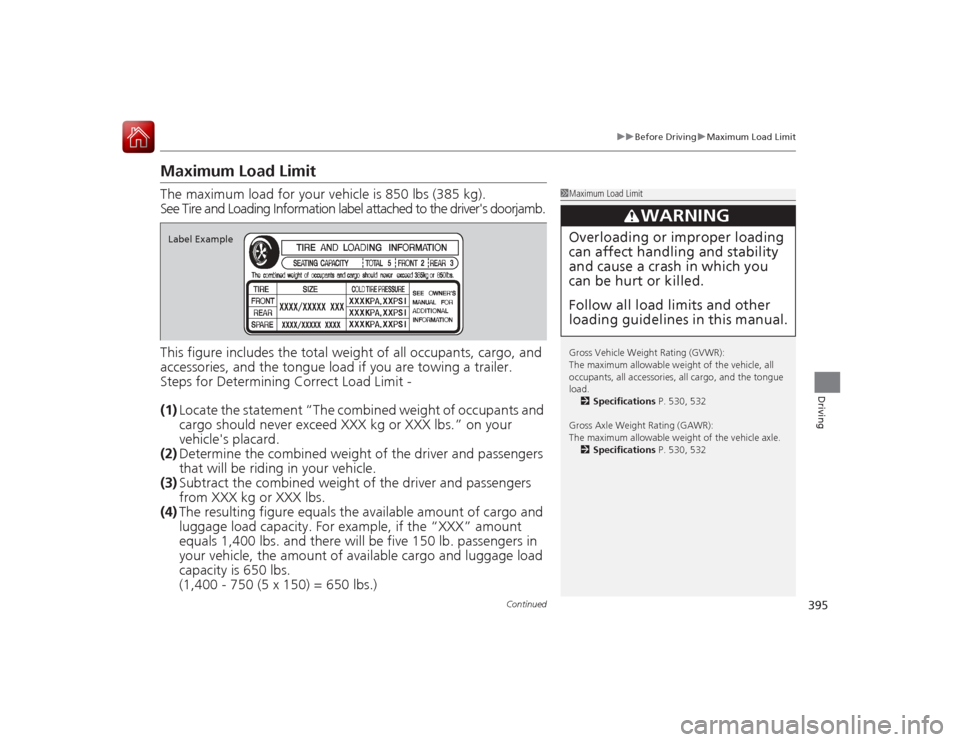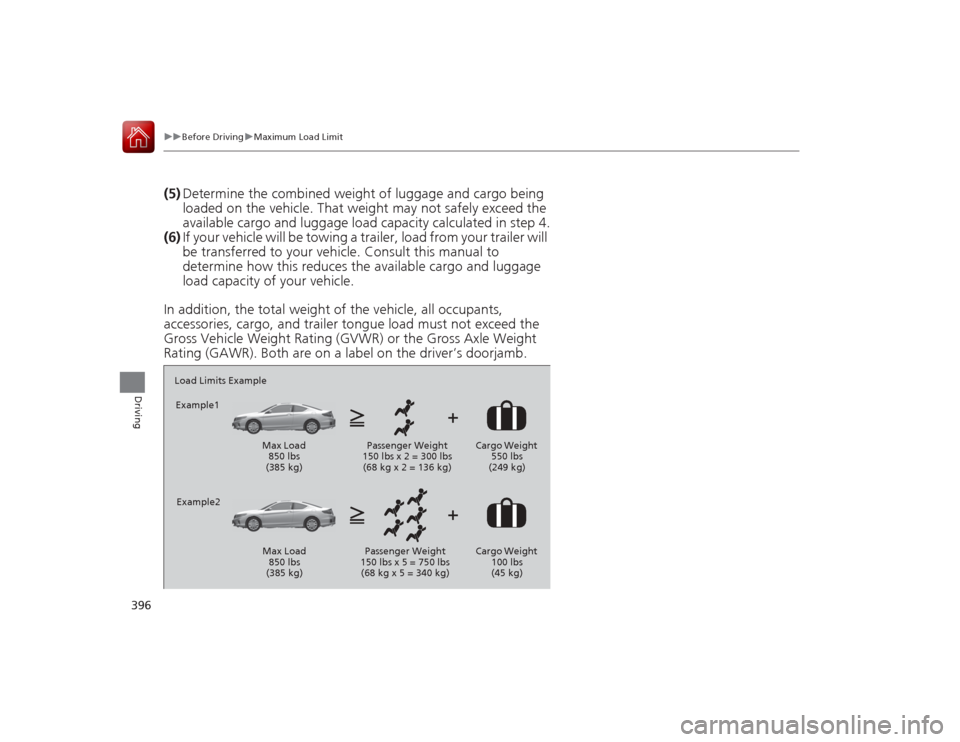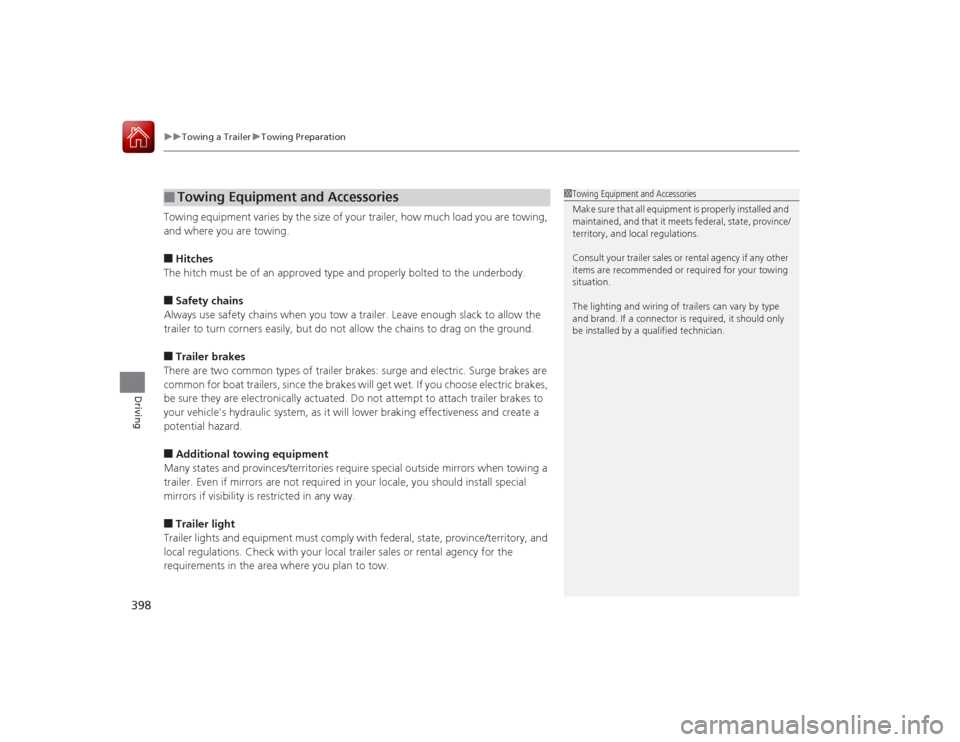2015 HONDA ACCORD COUPE towing
[x] Cancel search: towingPage 3 of 557

ContentsThis owner’s manual should be considered a permanent part of the
vehicle and should remain with the vehicle when it is sold.
This owner’s manual covers all models of your vehicle. You may find
descriptions of equipment and features that are not on your
particular model.
Images throughout this owner’s manual (including the front cover)
represent features and equipment that are available on some, but
not all, models. Your particular model may not have some of these
features.
This owner’s manual is for vehicles sold in the United States and
Canada.
The information and specifications included in this publication were
in effect at the time of approval for printing. Honda Motor Co., Ltd.
reserves the right, however, to discontinue or change specifications
or design at any time without notice and without incurring any
obligation.
2Safe Driving P. 27For Safe Driving P. 28 Seat Belts P. 32 Airbags P. 392Instrument Panel P. 67Indicators P. 68 Gauges and Displays P. 812Controls P. 85Clock P. 86 Locking and Unlocking the Doors P. 88
Opening and Closing the Moonroof
* P. 109
Adjusting the Seats P. 127
2 Features P. 149Audio System P. 150 Audio System Basic Operation P. 156, 178, 211
Customized Features P. 274 HomeLink® Universal Transceiver
* P. 312
2 Driving P. 391Before Driving P. 392 Towing a Trailer P. 397
Refueling P. 447 Fuel Economy P. 4492Maintenance P. 451Before Performing Maintenance P. 452 Maintenance Minder
TM P. 455
Checking and Maintaining Wiper Blades P. 483
Climate Control System Maintenance P. 497
2 Handling the Unexpected P. 503Tools P. 504 If a Tire Goes Flat P. 505
Overheating P. 518 Indicator, Coming On/Blinking P. 5202Information P. 529Specifications P. 530 Identification Numbers P. 534
Emissions Testing P. 537 Warranty Coverages P. 539
Page 4 of 557

Contents
Child Safety P. 52Exhaust Gas Hazard P. 64Safety Labels P. 65Opening and Closing the Trunk P. 99 Security System P. 103 Opening and Closing the Windows P. 106
Operating the Switches Around the Steering Wheel P. 110 Adjusting the Mirrors P. 125
Interior Lights/Interior Convenience Items P. 135 Climate Control System P. 144Audio Error Messages P. 264General Information on the Audio System P. 270
Bluetooth® HandsFreeLink ® P. 314, 351 Compass
* P. 389
When Driving P. 401 Braking P. 440Parking Your Vehicle P. 444
Accessories and Modifications P. 450Maintenance Under the Hood P. 459 Replacing Light Bulbs P. 475
Checking and Maintaining Tires P. 485 Battery P. 494 Remote Transmitter Care P. 495
Cleaning P. 498Engine Does Not Start P. 511 Jump Starting P. 514Shift Lever Does Not Move P. 517
Fuses P. 524 Emergency Towing P. 527Devices that Emit Radio Waves P. 535 Reporting Safety Defects P. 536
Authorized Manuals P. 541 Customer Service Information P. 542
Quick Reference Guide
P. 4
Safe Driving
P. 27
Instrument Panel
P. 67
Controls
P. 85
Features
P. 149
Driving
P. 391
Maintenance
P. 451
Handling the Unexpected
P. 503
Information
P. 529
Index
P. 546
Page 23 of 557

22Quick Reference Guide
Handling the Unexpected
(P 503)
Flat Tire
(P 505)
● Park in a safe location and replace the
flat tire with the compact spare tire in the
trunk.
Indicators Come On (P 520)
●Identify the indicator and consult the
owner's manual.
Engine Won't Start (P 511)
● If the battery is dead, jump start using a
booster battery.Blown Fuse
(P 524)
● Check for a blown fuse if an electrical
device does not operate.
Overheating
(P 518)
● Park in a safe location. If you do not see
steam under the hood, open the hood,
and let the engine cool down.
Emergency Towing (P 527)
●Call a professional towing service if you
need to tow your vehicle.
Page 392 of 557

391
Driving
This chapter discusses driving, refueling, and information on items such as accessories.
Before DrivingDriving Preparation .......................... 392
Maximum Load Limit........................ 395
Towing a Trailer Towing Preparation .......................... 397
Driving Safely with a Trailer .............. 399
Towing Your Vehicle ........................ 400
When Driving Starting the Engine .................. 401, 403
Precautions While Driving................. 407
Automatic Transmission/CVT
*.......... 408
Shifting ............................ 409, 413, 417
ECON Button ................................... 420 Cruise Control ................................. 421
Forward Collision Warning (FCW)
*.... 424
Lane Departure Warning (LDW)*..... 428
Vehicle Stability Assist (VSA
®), aka Electronic
Stability Control (ESC), System ............... 432
LaneWatch
TM*.......................................... 434
Tire Pressure Monitoring System (TPMS) ... 436
Tire Pressure Monitoring System (TPMS) - Required Federal Explanation ......... 438
Braking
Brake System ................................... 440
Anti-lock Brake System (ABS) ........... 442 Brake Assist System ......................... 443
Parking Your Vehicle When Stopped ................................ 444
Multi-View Rear Camera .................. 445
Rearview Camera ............................. 446
Refueling Fuel Information .............................. 447
How to Refuel ................................. 448
Fuel Economy Improving Fuel Economy .................. 449
Accessories and Modifications ........ 450
* Not available on all models
Page 396 of 557

395
uuBefore Driving uMaximum Load Limit
Continued
Driving
Maximum Load LimitThe maximum load for your vehicle is 850 lbs (385 kg).
See Tire and Loading Information label attached to the driver's doorjamb\
.
This figure includes the total weight of all occupants, cargo, and
accessories, and the tongue load if you are towing a trailer.
Steps for Determining Correct Load Limit -
(1) Locate the statement “The combined weight of occupants and
cargo should never exceed XXX kg or XXX lbs.” on your
vehicle's placard.
(2) Determine the combined weight of the driver and passengers
that will be riding in your vehicle.
(3) Subtract the combined weight of the driver and passengers
from XXX kg or XXX lbs.
(4) The resulting figu re equals the availabl e amount of cargo and
luggage load capacity. For example, if the “XXX” amount
equals 1,400 lbs. an d there will be five 15 0 lb. passengers in
your vehicle, the amount of available carg o and luggage load
capacity is 650 lbs.
(1,400 - 750 (5 x 150) = 650 lbs.)
1 Maximum Load Limit
Gross Vehicle Weight Rating (GVWR):
The maximum allowable weight of the vehicle, all
occupants, all accessories, all cargo, and the tongue
load.
2 Specifications P. 530, 532
Gross Axle Weight Rating (GAWR):
The maximum allowable weight of the vehicle axle. 2 Specifications P. 530, 532
3
WARNING
Overloading or improper loading
can affect handling and stability
and cause a crash in which you
can be hurt or killed.
Follow all load limits and other
loading guidelines in this manual.
Label Example
Page 397 of 557

396
uuBefore Driving uMaximum Load Limit
Driving
(5) Determine the combined weight of luggage and cargo being
loaded on the vehicle. That weight may not safely exceed the
available cargo and luggage load capacity calculated in step 4.
(6) If your vehicle will be towing a trailer, load from your trailer will
be transferred to your vehicle. Co nsult this manual to
determine how this reduces the available cargo and luggage
load capacity of your vehicle.
In addition, the total weight of the vehicle, all occupants,
accessories, cargo, and trailer tongue load must not exceed the
Gross Vehicle Weight Rating (GVWR) or the Gross Axle Weight
Rating (GAWR). Both are on a lab el on the driver’s doorjamb.Load Limits Example
Example1
Max Load 850 lbs
(385 kg) Passenger Weight
150 lbs x 2 = 300 lbs (68 kg x 2 = 136 kg) Cargo Weight
550 lbs
(249 kg)
Example2
Max Load 850 lbs
(385 kg) Passenger Weight
150 lbs x 5 = 750 lbs (68 kg x 5 = 340 kg) Cargo Weight
100 lbs
(45 kg)
Page 398 of 557

397
Continued
Driving
Towing a TrailerTowing PreparationYour vehicle can tow a trailer if you carefully observe the load limits, use the proper
equipment, and follow the towing guidelines. Check the load limits before driving.
■Total trailer weight
Maximum allowable weight of the trailer,
cargo, and everything in or on it must not
exceed 1,000 lbs (450 kg). Towing loads in
excess of this can seriously affect vehicle
handling and performance and can damage
the engine and drivetrain.■Tongue load
The weight of the tongue with a fully loaded
trailer on the hitch should be approximately
10% of the total trailer weight.
• Excessive tongue load reduces front tire
traction and steering control. Too little
tongue load can make the trailer unstable
and cause it to sway.
• To achieve a proper tongue load, start by
loading 60% of the load toward the front
of the trailer and 40% toward the rear.
Readjust the load as needed.
■
Towing Load Limits
1Towing Load Limits
Check if all loads are within limits at a public scale.
If a public scale is not available, add the estimated
weight of your cargo load to the weight of your
trailer (as quoted by the manufacturer), and the
tongue load.
Break-in Period
Avoid towing a trailer during your vehicle's first 600
miles (1,000 km).
Never exceed the gross weight ratings.
Gross weight information
2 Vehicle Specifications P. 530, 532
3
WARNING
Exceeding any load limit or improperly
loading your vehicle and trailer can cause a
crash in which you can be seriously hurt or
killed.
Check the loading of your vehicle and
trailer carefully before starting to drive.
Total LoadTongue LoadTongue Load
Page 399 of 557

uuTowing a Trailer uTowing Preparation
398Driving
Towing equipment varies by the size of your trailer, how much load you are towing,
and where you are towing.■Hitches
The hitch must be of an approved typ e and properly bolted to the underbody.■Safety chains
Always use safety chains when you tow a trailer. Leave enough slack to allow the
trailer to turn corners easily, but do not allow the chains to drag on the ground.■Trailer brakes
There are two common types of trailer brakes: surge and electric. Surge brakes are
common for boat trailers, since the brakes will get wet. If you choose electric brakes,
be sure they are electronically actuated. Do not attempt to attach trailer brakes to
your vehicle's hydraulic system, as it will lower braking effectiveness and create a
potential hazard.■Additional towing equipment
Many states and provinces/territories require special outside mirrors when towing a
trailer. Even if mirrors are not required in your locale, you should install special
mirrors if visibility is restricted in any way.■Trailer light
Trailer lights and equipment must comply with federal, state, province/territory, and
local regulations. Check with your local trailer sales or rental agency for the
requirements in the area where you plan to tow.■
Towing Equipment and Accessories
1 Towing Equipment and Accessories
Make sure that all equi pment is properly installed and
maintained, and that it meets federal, state, province/
territory, and local regulations.
Consult your trailer sales or rental agency if any other
items are recommended or required for your towing
situation.
The lighting and wiring of trailers can vary by type
and brand. If a connector is required, it should only
be installed by a qualified technician.